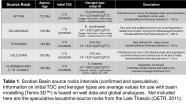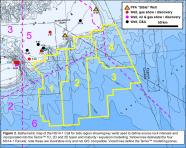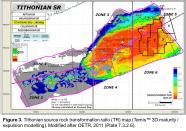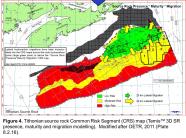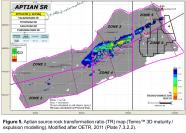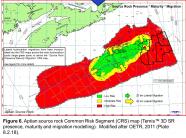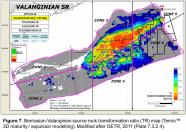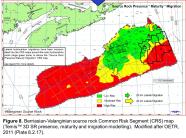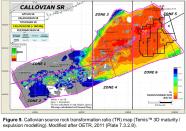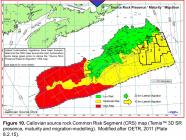Source Rocks and Maturation
Overview
Five regional source rock intervals are known for the Scotian basin, and were modelled in the OETRA Play Fairway Analysis – PFA (OETR, 2011). They are grouped into major or minor potential contributors of hydrocarbons that are dependent on their geochemical and spatial attributes, depth of burial, maturation and other available data (Figure 1):
MAJOR
- Late Jurassic: Tithonian carbonate to deltaic transition MFS (Abenaki / Upper Mic Mac to Lower Missisauga formations) – OIL & GAS
- Early Jurassic: Pleinsbachian to Toarcian restricted to near-normal marine (Mohican and Iroquois Formation distal equivalents) – Dominantly OIL, Minor GAS
MINOR
- Early Cretaceous: Intra-Aptian deltaic MFS (Naskapi Member, Logan Canyon Formation) – Dominantly GAS, Minor OIL
- Early Cretaceous: Berriasian / Valanginian deltaic MFS (Lower Missisauga Formation) – Dominantly GAS
- Middle Jurassic: Callovian marine MFS (Misaine Member, Abenaki Formation) – Dominantly GAS, Minor OIL
Within the Call for Bids NS14-1 Call region, all defined source intervals were modelled using the Temis™ basin modelling program (1D, 2D and 3D modules) to determine maturation, expulsion, trapped hydrocarbon volumes and characteristics. Several of the source rocks are believed to have the potential to have generated hydrocarbons, with the Late Jurassic Tithonian major source interval the best. The two Early Cretaceous intervals – Berriasian / Valanginian, and Aptian – are considered minor source rocks though in the deep water successions they may play a greater role. The Callovian interval is greatly influenced by deltaic sedimentation though may have potential distally where under marine influence.
As currently defined by the PFA, the Jurassic source rocks in the deeper parts of the Call parcels are deeply buried and are modelled to be mostly mature to over mature. The products of early hydrocarbon generation and migration would therefore be compromised by risks associated with trap formation, preservation, reservoir degradation, and tectonism. However, new research by the CNSOPB (see “Eastern Scotian Slope Regional Interpretation“ Section of this report) has revised the stratigraphic position of the important J152 (Tithonian) seismic marker such that it is at shallower depths and less mature, thus significantly improving the potential to generate hydrocarbons. New source rock modelling is therefore required to better quantify its petroleum potential.
Since the first well in 1967, natural gas has been the predominant hydrocarbon discovered and produced in the Scotian Basin, though significant quantities of light oil have also been found and produced. Liquid petroleum – oils and condensates – has been analyzed and differentiated into three to five families as detailed below.
Source Rocks
Research on the identification and characterization of Scotian Basin source rock intervals has been ongoing since the mid-1970s. Most of the published geochemical research was by researchers of the Geological Survey of Canada (e.g. J.P. Bujak, T.G. Powell, L.R. Snowden, D.R. Issler, M.G. Fowler, M. Obermajer and M.P. Avery) and others such as P.K. Mukhapadhyay (see References for representative citations). Concurrently, the petroleum industry undertook similar studies and analyses, as well as others by consultants and academics, the results of which are available from the CNSOPB’s Geoscience Research Centre / Data Management Centre. The province of Nova Scotia’s recent Play Fairway Analysis (OETR, 2011) compiled and updated historical research on petroleum source rocks, and in addition to undertaking new analyses incorporated these into new petroleum systems modelling for the basin.
The cumulative result of these studies has identified the main source rock intervals, and characterised the properties of several families of oils (Table 1). They range from Middle Jurassic to Early Cretaceous age and are marine shales of the Verrill Canyon Formation and its lateral MFS expression within the proximal fluvial-marine successions of the Mic Mac, Missisauga and Logan Canyon formations. Other source rock intervals identified in Early Cretaceous and younger strata have good TOCs (e.g. Logan Canyon Formation; 2-4%) but shallow in the stratigraphic succession of the Call for Bids area and hence immature. A fifth new marine source rock interval of Early Jurassic age is inferred from geochemical (seep and petroleum analysis) evidence and comparative studies that are described below (OETR, 2011). A speculative sixth source (Late Triassic-earliest Jurassic) is inferred from onshore successions but has no direct evidence to date.
- Late Jurassic – Tithonian carbonate to deltaic transition MFS
Abenaki / Upper Mic Mac to Lower Missisauga formations
The Late Jurassic (Tithonian) MFS succession is believed to be the largest contributor of hydrocarbons in the 2014 Call region based on Temis™ basin modelling. It was deposited during the transition from carbonate (Abenaki Fm.) to deltaic (Mic Mac Fm.) sedimentation. It is recognized as a MFS deposited in a shallow, open marine (neritic) shelf setting that appears to have been slightly anoxic. Distally it corresponds to the lower part of the Verrill Canyon Fm. Though penetrated in a number of wells, this source rock can been difficult to sample due to the use of lignosulfate mud additives and oil-based muds when approaching the underlying overpressure zone. This interval usually corresponds with the top of the Jurassic (approximate to Abenaki / Mic Mac formations) that is near the MFS. Kerogen microscopy of carefully selected cuttings samples has thus become the best way to define / identify this source rock. It is composed of Type IIA/IIB-III kerogen capable of generating gas, condensate and oil from a terrestrial to mixed terrestrial-marine source (Mukhopadhyay and Wade, 1990).
Within the southern margin of the Huron Subbasin outside of and bounding the Call region, the South Griffin J-16 and Louisbourg J-47 wells provide useful information on this source interval (Figure 2). The equivalent succession in the Dauntless D-35 well to the east is dominated by fluvial-deltaic sandstones, and the distal Tantallon M-41 well did not reach this source interval, instead bottoming in Missisauga formation equivalent Berriasian-Valanginian age sediments. As such, there is no lithological information on this source rock in the Call region though it has been interpreted to be present and modelled.
The South Griffin J-13 is a so-called PFA “Bible” well and is a key well in the Call region. It is near the outer distal edge of the underlying South Griffin Ridge. The Tithonian interval (~4350-4650 m) is comprised of an alternating series of micritic to oolitic limestones, grey to brown shales, rare siltstones and very fine grain sandstones with fair to good porosity, with the MFS at 4443 m. The TOC is quite lean (0.09-0.55% range) over this 300 m interval and displaying low HI and OI ranges (22-133) and (28-162) respectively (data derived from GSC, 1986 (Basin Database) as presented in OETR, 2011; Plate 4-4-7). It is unknown why the TOC is so markedly lower than those from the same stratigraphic interval in related wells; local facies variations? However, the narrow 4370-4390 m interval just above the MFS reveals higher range values for TOC (0.64-2.05) but similar low HI (101-185) and OI (7-36) ranges. Regardless of the TOC, these indexes confirm indicate a depleted source rock at this depth interval.
Though not a PFA “Bible” well, Louisbourg J-47 offers additional and more positive information on Tithonian source rock potential. The well is located on the inboard edge of the South Griffin Ridge and here the Tithonian interval (~4100-4400 m) is composed of fluvial / shallow marine sand- and siltstones with occasional limestones. Average TOC is approximately 3% with a maximum of 7%. The HI (80-525) and OI (20-175) ranges in the shale samples indicates a Type II-III mix of kerogens that are gas-prone (Type IIB/III of Mukhopadhyay and Wade, 1990). Though few shales are present, TOC analysis and pyrolysis of samples from these interbeds from the top of the Tithonian (4000-4020 interval) as well as sample extracts suggest the presence of “…waxy sapropel-rich horizons which have very good source rock potential. Lateral equivalents of these horizons if more thickly developed off-structure will be important source rock beds. On structure, however, these horizons are immature (Ro=4.5-5.0) and appear too patchily developed to constitute significant oil source horizons” (Robertson Research, 1984).
Generally, the average TOCs in the Tithonian interval for the Scotian basin are 2-3% with maximum values approaching 7% (e.g. Louisbourg J-47), and the HI and OI indicate a Type IIB-III / Type III kerogen that is mostly gas-prone (Mukhopadhyay and Wade, 1990; OETR, 2011). Maturation in the Louisbourg well (average TOC=3%) is moderate (Ro=0.7%) and retains the potential to generate hydrocarbons. In contrast, shales of the Tithonian MFS are deeper in the South Griffin well, and while having a similar average TOC of 2% (1.25-1.64% range), the very low HI and low OI values and high maturation (Ro=1.6-1.81%) indicate a depleted source rock (Mukhopadhyay and Wade, 1990).
There is evidence that a similar Late Jurassic - Early Cretaceous oil-prone source rock exists in the Baltimore Canyon Trough region (Sunde and Coffey, 2009). Geochemical biomarker analysis of remnant oils from an onshore well indicates they were sourced from a shale / marine marl succession deposited in a distal marine to slope depositional environment. The presence of oleanane is interpreted to support a Cretaceous age. Malinconico and Weems (2011) studied the geothermal gradient and maturity of a number of wells on the U.S. East Coast and concluded that the maturity of wells in the region was low (Ro=0.4-0.6%). As such, the Cretaceous succession could not have generated the observed oils. This suggests the low maturity indicates that the remnant oils were preserved in carrier beds and oil migration was a later phase. The probable distally-equivalent source rock would now be more deeply buried and currently within the oil window. Such a scenario could exist in the deep water equivalent section offshore Nova Scotia.
As noted previously, two younger Cretaceous source intervals, and an older Middle Jurassic one may have generated hydrocarbons in the Call region, though the former would have been modest contributors to the resource endowment. Some potential may exist in deep water.
- Early Cretaceous – Intra Aptian deltaic MFS
Naskapi Member, Logan Canyon Formation
Within the Call for Bids area, the Naskapi source rock interval is best described in the South Griffin J-16 well in the Huron Subbasin. It is the basal member of the Logan Canyon Formation and represents a major MFS interval following deltaic and shallow marine deposition of the Missisauga Formation (Wade and MacLean, 1990). The Naskapi’s depositional environment is interpreted to range from tidal flat to marginal marine. It is a major regional shale-dominated sequence that thickens seaward with increasing shale content, and proximal to the northern (marginal) part of the Scotian Basin it thins and becomes increasingly sand-dominated. Where it is thick enough, it acts as a regional seal, with a number of gas and oil shows and discoveries in overlying and underlying sandstones; e.g. Panuke (top of Upper Missisauga Fm.) and Cohasset (base Logan Canyon Fm. (Cree Member) oil fields. Distally it merges with the shale-dominated slope succession of the Verrill Canyon formation.
The Naskapi has good source rock potential, with maximum TOC values slightly greater than 2%, and ranging between 1-2%. Within the South Griffin J-16 well, the hydrogen and oxygen indices (HI & OI) range between 50-75 and 60-160, respectively, indicating a Type III kerogen. In this well and the Dauntless D-35 well further to the east, the vitrinite reflectance (VR) is moderate (Ro=0.5-0.6) revealing incipient maturation only, hence in the Huron Subbasin on the Scotian Shelf it is mostly immature. The Tantallon M-41 well reveals the approximately equivalent section to have a similar TOC average and ranges though with higher HI (151-307) and OI (62-150) range values (Anadarko, 1999). This suggests a mix of Type II and III kerogens and reflects contributions from deltaic / deep outer shelf – upper slope depositional environments.
- Early Cretaceous – Berriasian / Valanginian deltaic MFS
Middle and Lower Missisauga Formation
The Berriasian / Valanginian source rock is not a discrete interval but is composed of a number of transgressive, MFS marine shales within the deltaic Missisauga Formation. Based on PFA “Bible” wells in the Huron Subbasin, and elsewhere in the Scotian Basin, the source rock shales have TOC values that range from 1-2%, averaging about 1%, with the organic matter dominated by Type III kerogens. Distally, the source rock improves in thickness and richness and has the potential to be a very good oil source (Barnard and Dodd, 1984).
On the Scotian Shelf, the Berriasian / Valanginian source interval is volumetrically small and thus is considered a minor source rock. However, data from the deep water Annapolis G-24 and Crimson F-81 wells reveal deep water facies having a TOC range of 1.5-2.5% with the succession more deeply buried, such that the entire Missisauga formation is sufficiently organic-rich and mature to charge reservoirs (OETRA, 2011; Plates 4-4-4 & 4-4-5). For the NS-14-1 area, the equivalent interval in the Tantallon M-41 well is almost entirely shales interpreted to have been deposited in a pro-delta to outer shelf setting and transported into deeper water through mass transport / slumping into the upper slope region (Piper et al., 2010). Analysis of the well by Anadarko (1999) shows the TOC’s range from 1.3-2.3 (~1.9 average) with moderate HI (168-427) and low OI (86-183) ranges inferring a mix of Type II/III kerogens with the potential to generate gas and some liquids.
- Middle Jurassic – Callovian marine MFS
Misaine Member, Abenaki Formation
The Callovian MFS is represented in the Scotian Basin by the Misaine Member, and is the only siliciclastic succession within the thick, carbonate-dominated Abenaki Formation. The velocity contrast between the Misaine MFS shales and underlying Scatarie Member (J213 seismic marker) platformal limestones results in the creation of an excellent regional seismic marker. As such, the Misaine can be mapped throughout the Scotian Basin though is lost in the distal parts of the basin. It is present deep in the Sable and Huron subbasins though has been penetrated in wells drilled near and on the basin hingeline fault and on structural elements such as the South Griffin Ridge.
There is no direct information available on the source rock potential of the Misaine in the NS14-1 Call parcels. Based on data from adjacent wells / basins, the Misaine shale contains Type IIA-IIB and II-III oil- and gas-prone kerogens with an average TOC of 2.0% (Mukhopadhyay and Wade, 1990). In the Huron Subbasin bounding the northern margin of the Call region, only the Louisbourg J-47 well penetrated this interval (~5400-5500 m) that is dominated by fine grain sandstones, siltstones and minor shales. Contamination by drilling additives compromised evaluation of the interval’s source rock characteristics. It was determined that the shales’ organic matter was dominated by vitrinite (Type III) kerogens with fair TOCs (0.71-1.28%), were moderately mature (Ro=0.8) and had fair potential to generate gas (Robertson Research, 1993). Distally and away from deltaic influences, the source interval should have higher proportions of marine-dominated kerogens (Type II) that could generate liquid hydrocarbons. However, in this setting they may be deeply buried, over mature and exhausted of hydrocarbon potential.
- Early Jurassic – Pleinsbachian to Toarcian restricted to near-normal marine
Mohican and Iroquois Formation distal equivalents
Though not yet penetrated, empirical evidence and comparative analogue studies increasingly support the presence of an oil-prone, Type II marine Pleinsbachian to Toarcian age regional source rock interval in the Scotian Basin. The most recent compilation and assessment of source rocks in the Scotian basin is that of the OETR’s 2011 Play Fairway Analysis (PFA). The report reviewed and consolidated extant data and interpretations with new data acquired from analyses of bottom seeps (GeoMark, 2001), as well as undertaking its own analyses. From these data and comparative study with known source rocks from other circum-Atlantic basins, a new, fifth regional source rock interval is postulated.
Within the NS14-1 Call region, this succession is very deeply buried and thus over-mature. However, to the northeast is the Primrose oil and gas Significant Discovery. The structure is closure above a large, shallow salt diapir with hydrocarbons are reservoired in fractured Campanian-Maastrichtian Wyandot formation chalks (gas and condensate), Logan Canyon (gas and condensate), and Early Jurassic Iroquois formation dolomites (oil). Analysis of the liquids from the three Primrose wells and different reservoir intervals places them in a family of oils suggestive of being sourced from different sources (i.e. mixed with maturation variations); cf. Powell and Snowdon (1979); Mukhopadhyay et al. (1995); Illich et al. (1999); Fowler and Obermajer (2001) – see below. This could be explained by phased maturation and migration oils from various sources migrating up along faults surrounding the diapir over the long period of its growth. New analysis for diamonds in these liquids might provide important information on their maturation history and potential sources. As such, contributions to the petroleum endowment in the Call region cannot totally be discounted.
Maturation / Expulsion
As part of the Play Fairway Analysis (OERA, 2011) 1D (20 wells), 2D (single regional seismic lines) and 3D basin modelling was performed utilizing the Temis™ software that incorporated data on petroleum system elements and processes. From the 3D modelling, Common Risk Segment (CRS) maps were created to determine the probability of occurrence for source rock intervals (presence, maturity and migration), and for reservoir and seal intervals. From these, composite CRS maps were generated for five designated petroleum systems for the Scotian Basin. Burial history and maturation were modelled deriving information from published and newly acquired datasets.
For the 31 selected calibration wells, temperature, maturation and pressure data were derived to generate well and composite regional burial curves for temperature, maturation (vitrinite reflectance, Ro) and pressure. Maturation history and potential expelled hydrocarbons were calculated utilizing input parameters for each source rock interval (age, TOC, kerogen type, initial hydrogen index, thickness) (OETR, 2011; Plate 7-3-1-3a). Incorporating these data and results into the Temis™ 2D and 3D modelling programs generated the transformation ratio (TR) through time for selected source rock and play intervals for the entire Scotian Basin (TR defined as the observed versus initial hydrogen index; it differs for kerogen types) (OETR, 2011, Plate 7-3-1-3b). This is representative of the maturation level of a given kerogen (SR) as opposed to vitrinite reflectance (Ro) which is indicative of absolute maturity irrespective of kerogen type.
The Temis™ 3D maturity / expulsion modelling was run for the entire Scotian Basin and covers the six PFA-defined play zones. As shown in the relevant figures (below), the NS14-1 Call for Bids region straddles the southern third of the Zone 5, and northern two-thirds of Zone 6. Due to seismic and well data limitations, only about 20% of Parcel 4 (bounding Parcel 3 to the west), is shown in the modelling results. Similarly, the eastern 20% of Parcel 3 is not included in the results.
The Tantallon M-41 is the only one of the 31 PFA key regional wells that is located within the NS14-1 Call region (Parcel 1 in Zone 5 near the boundary with Zone 6). There are several key Temis™ calibration wells located outside of and along the northern boundary of the Call parcels located in the Huron Subbasin. Several other wells provided important information that was included in the modelling process (note: the asterisk indicates a key PFA “Bible” reference well):
Zone 6 (Sable Subbasin):
-
Tantallon M-41 * (Parcel 1)
Zone 5 (Huron Subbasin):
- South Griffin J-13 * (north of Parcel 2)
- Dauntless D-35 * (north of Parcel 4)
- Hesper P-52 * (far north of NS14-1 Parcels)
- West Esperanto B-78 * (far north of NS14-1 Parcels)
Existing TOC & Rock Eval Data (Geological Survey of Canada’s “BASIN” online database):
- Dauntless D-35 *
- Louisbourg J-47
- South Griffin J-13 *
Existing Maturation Data (Geological Survey of Canada’s “BASIN” online database):
- Dauntless D-35 *
- Louisbourg J-47
- Sachem D-76
- South Griffin J-13 *
The following section reviews the results of the Temis™ 3D maturation / expulsion modelling and summarizes the characteristics of the source rock intervals in the Call region starting with the main Tithonian interval and followed by the remainder. It should be noted that given the well distribution (especially in deep water and boundary areas), results were required to be extrapolated into the outer margins of the basin (OETR, 2011). For the associated figures (3-10), the black lines delineate the four NS14-1 Call for Bids Parcels, note that these are not GIS compatible and are for illustrative purposes only. The violet lines the Temis™ modelling zones, small red diamonds the key PFA “Bible” reference wells, and large red triangles the key “Bible” wells in / near the Call region; Tantallon M-41, South Griffin J-13 and Dauntless D-35. Note also the key 3000 m bathymetric contour; the dashed NE-SW trending blue line extending through Zones 2, 4 and 6.
Pointedly, there are no wells in these three deep water regions that comprise about 50% of the entire PFA study area. Furthermore, it should be noted that this modelling is based on defining and mapping of regional seismic horizons from the shelf into large regions with no well and limited seismic control. Changes in the vertical position of regional seismic markers would therefore have a profound influence on the determination of a source rock’s presence, character and expulsion potential.
Late Jurassic: Tithonian carbonate to deltaic transition MFS
Abenaki / Upper Mic Mac to Lower Missisauga formations
Dominantly OIL & GAS
Modelling of this source interval in the PFA (OERA, 2011) revealed that it should be considered as a significant contributor to the Scotian Basin’s hydrocarbon endowment. As described above, it represents deposition in a transitional setting from a carbonate-dominated marine (Abenaki) to siliciclastic fluvial-deltaic environment (Mic Mac). The source interval lithologies have an average TOC of about 3% composed of mixed Type IIA/IIB-III kerogens capable of generating gas, condensate, and oil (Mukhopadhyay and Wade, 1990). The deposition of this source is regional in scope centred in the central and eastern parts of the Scotian Basin.
Temis™ modelling indicates that the interval has a high TR with most hydrocarbons expelled over time (Figure 3). Expulsion started at ~136 Ma (5% TA) and covers entire region. Over-maturity (TA=95%) is variable, ranging from Early Cretaceous (~Aptian) to Paleogene at the margins of the Call region, and there is significant to very strong HC expulsion (>80%). Based on the TR map (Figure 3.2), this source rock has expelled all its hydrocarbons in Parcels 1 and 2, with 60-80% in Parcel 3 and the same on the western edge of Parcel 4. The oil mass fraction is about 40%, and while this Type II-III source tends to be more gas-prone, this fraction can exceed 60% locally where it is less mature.
The Tithonian CRS SR maps for this interval show that highest potential (low risk) exists along the southeastern (seaward) flank of the South Griffin Ridge and northern quarters of the Call parcels (Figure 4). Moderate risk encompasses the remainder of the parcels. Short and medium range lateral migration is modelled to be directed from the northwest. In situ very short range lateral and vertical migration is assumed for the deep water moderate risk region.
New mapping by the CNSOPB however, interprets the near top Jurassic J152 seismic marker (base of MS-4 / approximate base Tithonian; Figure 1) to be considerably higher in the section that mapped in the PFA (OETR, 2011) (see “Eastern Scotian Slope Regional Interpretation“ Section of this report). New Temis™ or related industry maturation / expulsion modelling of the Tithonian source rock is therefore necessary to re-assess this source rock’s potential in the NS14-1 Call parcels. It is believed that the results would be more positive for potential gas and liquid petroleum generation and trapping in the deep water region.
Early Cretaceous: Intra-Aptian deltaic MFS
Naskapi Member, Logan Canyon Formation
Dominantly GAS, Minor OIL
The Aptian source rock is well defined in the Sable, Huron and other shelf subbasins though is much harder to discern within the shale-dominated slope region though can be identified biostratigraphically. It is present high in the stratigraphic section and thus is immature (Figure 5). However, at the northern edge of the Call parcels it becomes thicker outboard of the South Griffin Ridge. Its deeper burial depth increases its maturity with a transformation ratio up to 30% though with limited generation of hydrocarbons (mostly gas). The CRS maps reveal that it has a high risk for presence / maturation / expulsion except for the northern half of Parcel 1 where it is modelled to have a low to moderate risk with a moderate (~40 km) lateral migration potential to the southeast (Figure 6). With the possible exception of the northwestern edge of Parcel 2, this source interval is modelled to have no hydrocarbon contributions in remainder of the Call parcels.
Early Cretaceous: Berriasian / Valanginian deltaic MFS
Lower Missisauga Formation
Dominantly GAS
This source interval’s distribution and maturation in the Call region follows the northeast-southwest trend along South Griffin Ridge and outer flank. Its transformation ratio ranges from 10-100% along the top of the Call parcels with expulsion beginning at about 130 Ma (Figure 7). Due to the presence of salt, its TR was not calculated and is thus shown as immature for the remainder of the region in deep water. The Berriasian / Valanginian CRS maps for this source rock interval indicate that the highest potential (low risk) exists along slope with almost all of Parcel 1 having low to moderate SR risk (Figure 8). This low-moderate risk extends into the northern half of Parcel 2 and most of Parcel 4. Parcel 3 is modelled to have a high SR risk. Short and medium range lateral migration is modelled to be directed from the northwest well into Parcels 1, 2 and 4. Should this source interval be developed in the deep water region, it could have a positive contribution to gas-charging in these three parcels should sufficient reservoirs be present.
Middle Jurassic: Callovian marine MFS
Misaine Member, Abenaki Formation
Dominantly GAS, Minor OIL
The Misaine Member is widespread across the Scotian Basin and Call region. Like the potential Early Jurassic source interval, the presence of underlying basement structural elements during the time of its deposition could have exerted an influence on its formation though to a lesser degree. Gas generated from this source interval might be that encountered and tested in the lower part of the Mic Mac Formation in the Louisbourg J-47 well above the South Griffin Ridge. This source rock is modelled to have almost complete expulsion of hydrocarbons (70-100%; gas, minor oil) in Parcels 1, 2 and 3, though there are no results for most of Parcel (Figure 9). Based on Temis™ modelling, the source rock reached maturity (TR=95%) at about 115 Ma (Aptian) for Parcels 1 and 2, though later (~60 Ma and younger) for Parcels 3 and 4 (Plate 7.3.2.9a; OERT, 2011). The Misaine’s overall TR in the Call region ranges from 80-100% and is therefore entirely exhausted with respect to its generative potential (Figure 3.8). The Misaine’s CRS maps reveal a moderate risk for source rock presence over all the Call parcels, with potential for moderate range (40 km) southeast-directed migration from the depocentre inboard of the South Griffin Ridge (Figure 10).
However, it is acknowledged that due to limited data (especially in deep water and eastern Scotian Slope, an accurate estimate of the Misaine’s potential is uncertain (OETR, 2011). No indication is given in the Temis™ results of landward, northwest-directed migration from any of the five recognized source rock successions in the deep water realm.
Hydrocarbons
The Scotian Basin is primarily gas-prone based on the great volume of source rock successions that had significant input from deltaic depositional systems. Most discoveries and production were of gas with associated condensates, yet there are a number of significant oil shows and discoveries, and previous oil production.
Since the late 1970s, researchers have undertaken analyses of these liquids in order to classify them and derive information related information on maturation and source rock relationships. Powell and Snowdon (1979) defined three oil and condensate families source predominantly by terrestrially dominated deltaic and marine shales of the Mic Mac, Missisauga and Verrill Canyon formations. In the 1990s, P.K. Mukhopadhyay undertook a comprehensive study of Scotian Basin hydrocarbon and source rock characterizations and relationships in association with the Geological Survey of Canada with a number of important papers and research contributions published. Mukhopadhyay et al. (1995), using cluster analysis of polyaromatic compounds, defined two oil families. Group I is comprised of high maturity condensates and associated gas derived from a terrestrial source (Type IIB/III kerogens). Group II oils from the Cohasset-Panuke-Balmoral fields suggest a marine source generated from mixed organic matter types (Type IIA/III kerogens).
In a geochemical analysis of oils and condensates from the Sable Subbasin, Illich et al. (1999) defined five oil families (three larger groupings). Two Families, A and B, were determined to have been generated from terrestrial type (III) organic matter from two closely related sources. The third, Family C, may represent the products of oil mixing since they have geochemical compositions indicative of terrestrial (Type III prodeltaic) and marine (Type II, carbonate-rich) source rocks. The remaining oils were grouped into two catch-all families, D and E. These contain very mature oils, some with unique compositions, and others that might be contaminated with drilling additives. They all have slightly different maturities that could represent separate source intervals. A Family D oil from the Venture D-23 well (4889m, DST No.4, 6U sand, Missisauga Fm.*) contained an above background level of gammacerane though the source rock and its age is unknown, but could be from an older, Early Jurassic source. (* Note: Illich et al. (1999) do not indicate the formation and DST number, and the 4771 m sample depth is incorrect.)
Fowler and Obermajer (2001) defined three families of liquid hydrocarbons (1, 2 and 3a / 3b) in the Scotian Basin. Each has characteristic properties, maturation profiles and geographic separation suggesting they came from separate source rocks, with most sourced from terrestrially-derived organic matter (Type II-III). The high gravity (47-55 API) oils from the Cohasset, Panuke, Balmoral and Penobscot fields are from Family 1 and are probably the least mature. Family 2 oils are found in the Arcadia, Banquereau, Glenelg and North Triumph shelf-edge fields in the Sable Subbasin and were generated from rocks with greater levels of higher land plant material than the others, or, that they are less mature. Family 3 oils may be due to a mixture of the Family 1 and 2 oils. Since Family 1 oils are only found in the Cohasset area on the west side of the Sable Subbasin, and Family 2 in the North Triumph area in the south, this significant geographic separation supports the interpretation that they are from different sources. This study indicated that the Scotian basin oils and condensates had Ro equivalents of between 0.7 and 0.94% confirming they were generated in the central part of the oil window.


